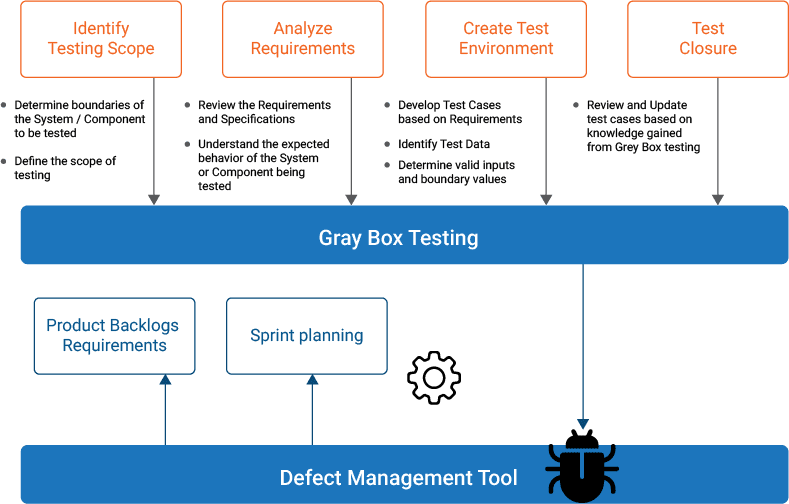- May 12, 2023
- Posted by: Sathish Kumar Balasubramani
- Category: Digital Assurance

As organizations move toward digital transformation, Quality Assurance’s role becomes critical. To ensure the desired quality and functionality are achieved, black box testing is not sufficient. We should have a strong strategical approach to test the evolving technologies covering all the layers – front end, middle layer, and backend. To achieve this, we need a techno-functional approach to testing which is Grey-Box testing.
Grey box testing is a software testing technique that includes the elements of black box testing and white box testing. It involves testing a system or application with partial knowledge of its internal workings. In other words, the tester has some knowledge of the software’s internal structure, but not the complete knowledge that a white box tester has. This makes grey-box testing a more realistic and efficient approach to testing than black-box testing, while still providing some of the benefits of white-box testing.

You can use a technique called “grey box testing” to troubleshoot the software and identify its weaknesses. It can be used as an objective, non-obstructive form of penetration testing. In this kind of testing, the focus is on an application’s internal workings rather than how those workings interact with one another.
Outcome-based grey box testing
Efficient Testing: Grey box testing allows testers to focus their efforts on specific areas of the system that are likely to have defects, which helps to reduce testing time and costs.
Realistic Testing: Unlike black box testing, grey box testing provides insight into the system’s internal workings, making it more realistic and closer to how end-user interact with the software.
Comprehensive Testing: Grey box testing allows testers to access the system’s front-end and back-end, which helps identify defects that may be missed in black box testing.
Better Test Coverage: With access to some of the system’s internal workings, grey box testing can help identify more comprehensive test cases, leading to better test coverage.
Improved Quality: By identifying defects that may be missed in black box testing, grey box testing can help improve the overall quality of the software.
The Process
In grey box testing, test cases are generated based on algorithms that assess internal states, application architecture knowledge, and programme behavior rather than by testers having to design test cases from scratch.
Steps to follow, while performing Grey Box testing:
- Identifying and choosing Inputs from white and black box testing approaches.
- Identify possible outputs from these inputs.
- Identify key paths for the testing level.
- Identify sub-functions for deep-level analysis.
- Identify responses for sub-functions.
- Detect probable outputs from sub-functions.
- Perform sub-function test cases.
- Assess and verify results.
Also read: IoT Testing Challenges and Solutions: Overcoming the Unique Obstacles of IoT Testing.
Layers of Grey box
Grey box testing involves examining each layer with greater depth.
Database Testing: During grey box testing of a database application, the tester may have access to the database schema but not the source code. As a result, they can more effectively and realistically test the database’s features.
API Testing: In API testing, a tester may have knowledge of the API’s internal structure and data flow, but not the complete code. This allows them to identify any issues in the API functions or data handling.
Security Testing: In security testing, a tester may know the system architecture and security protocols but not have entire knowledge of the source code. This helps them to identify any security vulnerabilities that may be missed in black box testing.
Performance Testing: The tester may know the system architecture and data flow, which allows them to identify any bottleneck or performance issues in the system.

Discover the benefits of Grey Box testing for your software quality. Contact us to learn
Click here
Inference
By reducing bugs at an earlier stage of the life cycle, grey box testing can help to improve quality by identifying defects in all the layers.
It offers some insights into how the system functions internally, making it more realistic and thorough. The transition to Grey Box testing is inevitable given how quickly digital technologies are developing. Higher quality and less expensive results will result from moving left and towards the earlier testing phase.




